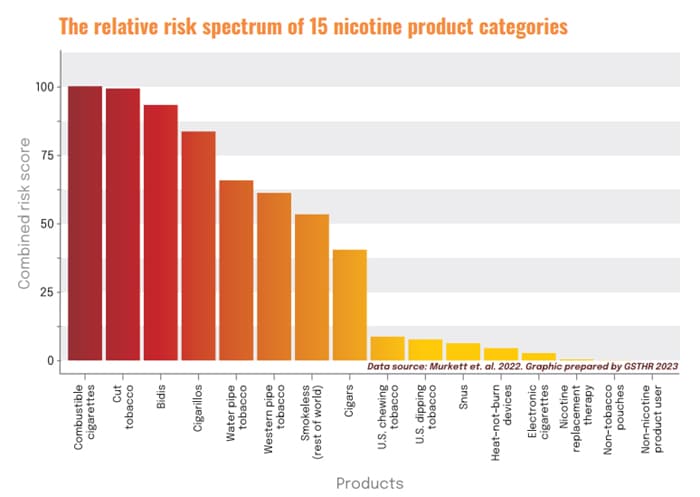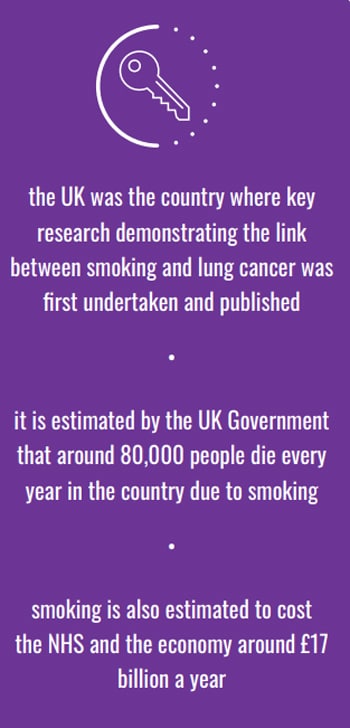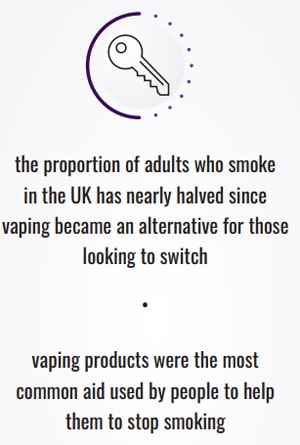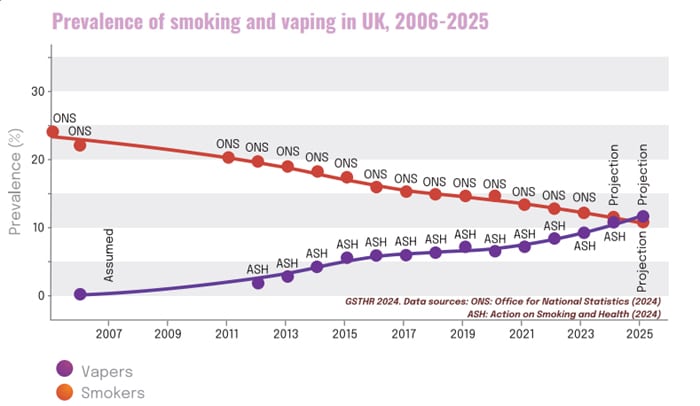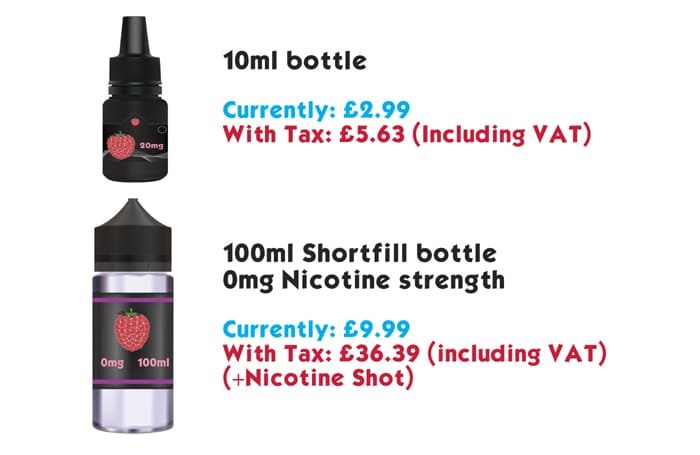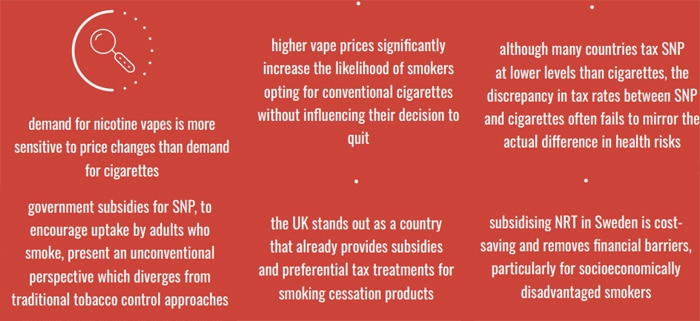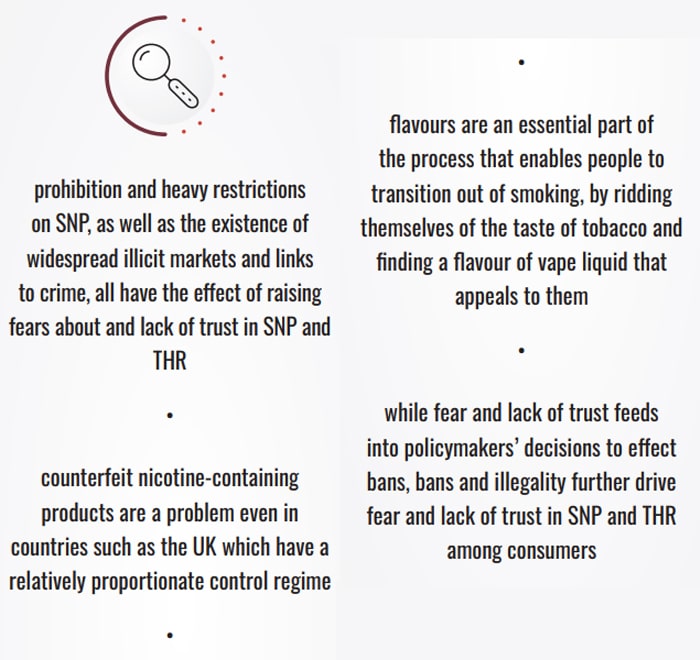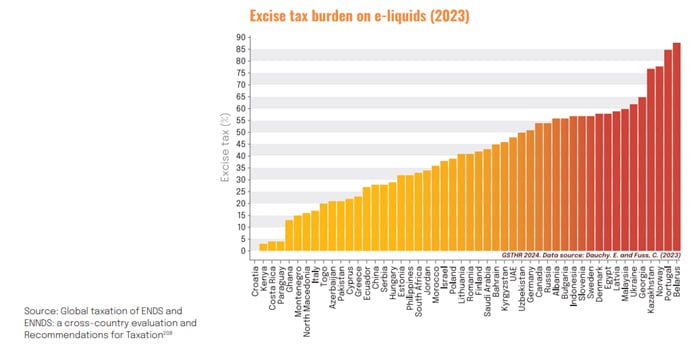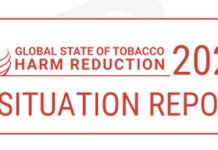The recently published GSTHR 2024 THR Situation report covers the worldwide situation at present in regards to THR (Tobacco Harm Reduction).
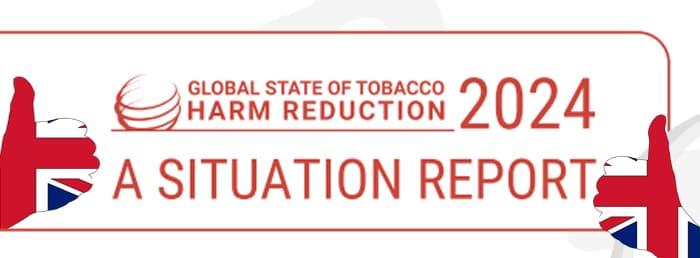
The first few chapters cover things from a global perspective and the final chapters use case studies from different countries to compare different THR strategies.
Surprisingly the UK fares really well! It is one of the 6 countries singled out for further exploration and things do look most rosy!
You can download the full report here: https://gsthr.org/resources/thr-reports/the-global-state-of-tobacco-harm-reduction-2024-a-situation-report/.
Sadly this appears to have been published before the recent Tobacco & Vapes Bill and there is no mention of the upcoming Disposable vape ban and vaping products duty (vape tax).
Plus just because I love graphics like this – I have to include the “Relative Risk Spectrum of 15 Nicotine Product Categories” that was contained in the report…
Introduction
This section dives deep into the UK situation regarding tobacco harm reduction.
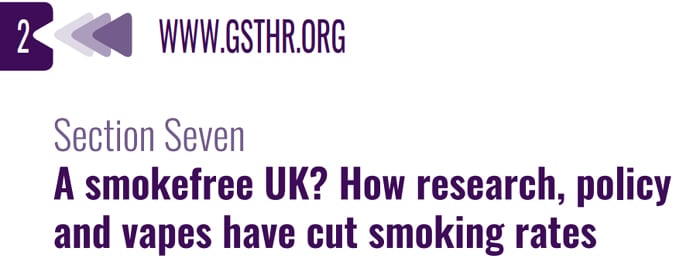
Also it points out how the UK was where key research linking smoking and lung cancer was first demonstrated and published.
It states that by the 2000’s the UK was known as a “global leader in tobacco control”.
Apparently the UK’s history with tobacco dates back to the 1500’s with Snuff, pipes and cigars being popular until machine rolled cigarettes were introduced in the late 19th century.
In 1950 the above mentioned link between smoking and cancer was first established, which was followed by a Royal College of Physicians landmark report “Smoking and Health” in 1962. This report is considered to be a turning point in the history of public health in the UK.
Data on smoking rates was first collected in 1974 and it showed 51% of men and 41% of women were smokers.
The rates have fallen over the subsequent years but it is still estimated that around 80,000 people die in the UK as a result of smoking. Also Cancer Research UK state that nearly 3 in every 4 lung cancer cases in the UK are due to smoking.
Thankfully the death rates attributable to smoking have been falling – from 244 per 100,000 between 2013 and 2015 to 202 per 100,000 between 2017 and 2019.
Apparently those who smoke see their GP 35% more than non-smokers and it is estimated that smoking costs the NHS (National Health Service) and economy around £17 billion a year!
Access To Safer Nicotine Products (SNP) In The UK
NRT
NRT (Nicotine Replacement Therapy) has been available in the UK since the 1980’s. This began with Nicotine Chewing Gum, then Nicotine Patches in 1992.
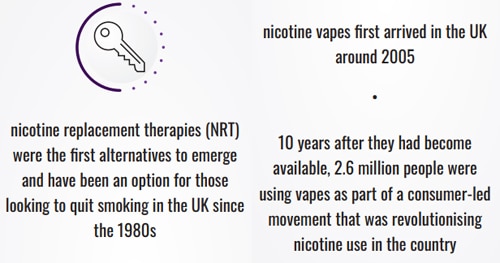
Vapes
Vapes arrived in around 2005 – which was a few years behind their invention in China. A UK vaping community developed rapidly with meets, shows, online forums and discussion boards. People chatted about the technology, modifications and flavours.
In 2010 the MHRA (Medicines and Healthcare products Regulatory Agency) were investigating bringing vaping products into the medicine licensing category. More than a thousand people who vaped submitted responses to the public consultation on the matter. The following year the MHRA announced it was no longer interested in categorising vapes as medicines but would be committing to further research and assessment.
In 2015 the Nicotine Inhaling Products (Age of Sale and Proxy Purchasing) regulations made it illegal to sell vapes to those under the age of 18.
2016 brought the Tobacco and Related Products Regulations which implemented the European TPD regulations. The TPD regulations are still in place.
By 2015 (just 10 years after they first became available) there were 2.6 million people using vapes.
HTP
HTP stands for “Heated Tobacco Products” – other names include HNB (Heat Not Burn) or could be known by device type such as IQOS.
These basically use standard type tobacco but it is not burnt. Instead it is heated to the optimum temperature to release the nicotine without all the harm caused by the by-products of combustion.
Obviously this is not the safest of tobacco harm reduction products but it is still significantly safer than combustible cigarettes and it has become a game changer in Japan for reducing smoking rates.
HTP are classed as Novel Tobacco Products in the UK and are subject to similar regulations as combustible tobacco. The slow uptake of the products and lack of awareness may be down to the fact they are strictly regulated.
Nicotine Pouches
Nicotine pouches contain no tobacco. They are small sachets with a filling material (usually vegetable fibres) which have been infused with nicotine and flavours.
These only appeared in 2019 and at present there are no age restrictions for sales. They are only subject to consumer product regulations. The original Tobacco and Vapes Bill in 2023 created by the previous conservative government was looking to make under age sales illegal.
The recent new version of the Tobacco and Vapes Bill 2024 has not specifically mentioned Nicotine Pouches but a few of the paragraphs reference “vapes and other nicotine products”…
“This sits alongside a ban in the Bill on vape advertising and sponsorship, as well as powers to restrict the flavours, display and packaging of all types of vapes, as well as other nicotine products.”
As we stand right now, the direction of the Tobacco and Vapes Bill is still unclear, so it may be further restriction is on the horizon for Nicotine Pouches too.
Snus
Unfortunately Snus is banned in the UK – alongside the rest of the EU (apart from Sweden) since 1992.
Even though the UK is no longer part of the EU – the Snus ban is still in place.
UK Vaping & Smoking Rates
Data was first collected in 1974 and smoking rates have been falling.
Nearly a quarter of UK adults (23.7%) were still smoking in 2005 when vapes first became available.
In 2015 5.4% of UK adults were vaping and 17.2% were smoking.
In 2019 the vaping rates rose to 7.1% and smoking fell to 14.5%.
By 2022 8.7% of the population (4.5 million people) were vaping and the smoking rate had dropped to 12.9% of adults (6.4 million people).
Basically the adult smoking rate in the UK has nearly halved since vaping became available.
2024 data shows that 11.6 (5.6 million people) were vaping. Also ASH (Action on Smoking & Health) found that more than half of those who had given up smoking in the past 5 years had used a vape in their last quit attempt.
The GSTHR report states…
“Our own projections based on ONS and ASH data, show that the proportion of adults smoking in the UK will continue to drop to just above 10% by 2025, a year in which the proportion of adults vaping is forecast to exceed the number who smoke for the first time”
The OHID (Office for Health Improvement & Disparities) review on vaping in 2022 found that vaping was the most common aid for people to quit smoking. Also during 2020 to 2021, those using a vape had more success in quitting smoking (64.9% for vaping compared to other methods 58.6%). Fruit flavours proved to be the most popular option at 35.5% with 22.5% preferring Menthol / Mint flavours.
Tobacco and vapes are subject to VAT (20%) but tobacco has an extra tobacco duty of 16.5% of the retail price plus £6.33.
At present there is only VAT added to vapes and vaping products. But the vaping products duty (vape tax) is due to be introduced in 2016 which will hike up the cost of e-liquid heavily. You can find out more about this here.
UK Approach To Tobacco Control
Traditionally the UK has not been strong on tobacco control up until the 1990’s. Prior to that there were small interventions such as cigarette commercials being banned from TV in 1965 and steady increases on the tax on cigarettes.
In 1999 local stop smoking services were introduced which was preceded by the 1998 “Smoking Kills” government white paper.
Smoking Kills introduced measures against tobacco advertising, sponsorship, investment in helping people to quit, free NRT on the NHS and changes to pubs and restaurants to introduce smoking and non-smoking areas.
Scotland were first to introduce smoking bans which prohibited smoking in certain public places which were “wholly or substantially enclosed”. England, Wales and Northern Ireland followed this shortly after.
Further regulation came with plain packaging, cigarette / tobacco packaging warnings, pricing, education and restrictions on flavours.
In 2019 the UK Conservative Government announced the “Smokefree 2030” goal. Basically this was the target year for smoking rates to be 5% or less.
The new Labour Government have pledged to progressively raise the legal purchase age of tobacco products (which may include HTP). This means there will become a point where young people will never be able to legally purchase tobacco.
Sadly the recent tobacco & vapes bill has many implications for vapers, including possible restrictions on flavours, packaging and promotion. On top of that of course is the disposable vape ban and vaping products duty which are on their way.
It appears that the GSTHR report was written before the new policies were announced.
UK Approach To Vaping As A Smoking Cessation Aid
In general the UK has been positive about vaping as a method of smoking cessation.
The first vape friendly stop smoking service was launched in 2014 by the NNA’s wonderful Louise Ross who was then the manager of the Leicester Stop Smoking Service.

Many initiatives were funded or launched by the Government / NHS to encourage people to switch from smoking to vaping.
Stoptober is one such campaign which included vapes in 2017.
In 2018 two NHS hospitals had vape shops on their premises. Both sites allowed vaping as long as this was away from doorways.
The biggest UK endorsement of vaping was the 2023 “Swap to Stop” campaign. Those who took part would be provided with a vape starter kit and behavioural support to help them stop smoking.
The NHS is positive about vaping and gives plenty of evidence for this. It is cautious in its response by saying that vaping is not harm free and should not be used by those who do not smoke.
Sadly again the UK positivity has declined and vaping is becoming more demonised. With daily scare stories in the UK media, disposable vape bans & vape tax – UK vapers are starting to feel victimised. The GSTHR report does not capture these events.
Conclusions & Future Predictions
I quote the following from the report…
“While smoking rates had been falling in the UK for many decades, the near 50% reduction in the proportion of adults who smoke that has taken place since vapes were introduced to the country shows the positive potential of Tobacco harm reduction. The UK experience adds further evidence that when appropriate, acceptable SNP, such as vapes, are made accessible and affordable, those who smoke will make the choice to switch to them in increasing numbers”.
Also the government is praised for allowing accurate scientific data to be published regarding the safety of vapes relative to smoking.
Sadly the report says that:
“The UK has to a large extent, so far, avoided the moral panics about vaping that have influenced political decisions in some countries, and has not experienced the degree of anti-vaping rhetoric and policy influence of prominent but ill-informed philanthropic foundations that has affected other parts of the world”
I would disagree with this. In the last couple of years the UK has had a lot of moral panic about vaping. Disposable vapes have caused uproar for instance and this has impacted the public opinion on vaping as a whole.
ASH UK found in 2023 that 4 in 10 smokers sadly believe that vaping is either as dangerous or equally as dangerous as smoking.
This public mis-perception of the risks is fuelled by many things but the UK media is one of the main culprits.
My Thoughts
In previous years I would have wholeheartedly agreed with this GSTHR report. But the latest regulations and possible upcoming regulations make the UK a far less vape friendly nation than it was.
I can see that nicotine pouches are likely to get further regulated. I hope this regulation is light and only focuses on age of sale and product quality.
We have upcoming disposable vape bans, the horrific 2026 e-liquid tax and the threats to flavours, packaging and promotion which were vaguely alluded to in the Tobacco and Vapes Bill.
The media frenzy of scare stories and even heavy methods used by schools are panicking the public further.
Many vapers see disposable vapes as being the issue. They certainly did the image of vaping in the UK no favours – especially in Scotland. A popular illicit market means under age buyers are getting hold of vapes and the enforcement agencies who are under resourced seem to be unable to cope with the influx.
Another issue with the illicit market is the standard of the product. The electrical components and / or e-liquid could be dangerous. With no standards applied for safety these are getting into the hands of even younger people.
The UK needs to tackle the illicit market, enforce the laws in a more robust way and possibly the introduction of a vape retailer licensing scheme may enable better monitoring and funding of vaping product sale enforcement.
I feel the heavier handed approach towards vaping of the last 2 years and the years to come will undo all the excellent work the UK have done in reducing smoking rates.
This graph from the GSTHR report, shows the excise tax burden on e-liquids globally as of 2023. I would like to see an update to this with the proposed UK Vape Tax included. I think we will be up towards the nasty end of the data sadly.
Vaping will be more expensive and less accessible than it was previously for UK adults. Spur of the moment switches to trying vaping will be less due to the cost, lack of disposable vapes, learning curve to use refillable equipment and lack of visibility at the point of purchase. We want to encourage someone buying tobacco to see an inexpensive easy to use vaping product (such as a disposable vape) to perhaps think they would be worth a try. This intervention could save someone’s life.
The UK are doing well with the stop smoking service and the encouragement to switch to vaping. Sadly though the funding for stop smoking services has been drastically reduced. I hope to see these services being better funded to help people make that switch.
I have to say I really applaud the full GSTHR Situation report. It states facts and is backed up with scientific and statistical data.
It is also really positive about harm reduction for improving the health of those impacted by combustible tobacco.
I really wish people in power would read this…
*Nudges the FDA, UK Government, WHO – and many more…
